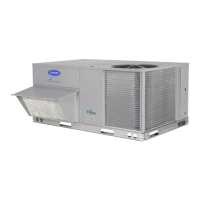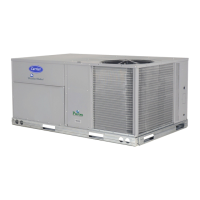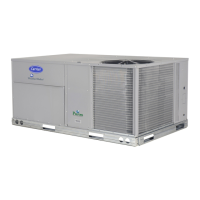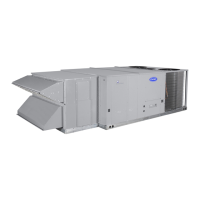35
to operate with Liquid Propane (LP) fuels. These ki ts
include new orifice spuds, new springs for gas valves a nd
a supply line low pressure switch. See section on Orifice
Replacement for details on orifice size selections.
Low NOx models include specially--sized orifices and use
of different flue flow limits and tube baffles. Because of
these extra features, c onversion of these models to LP is
not recommende d.
Fuel line pressure entering unit gas valve must remain
within specified range.
Table 11 – Liquid Propane Supply Line Pressure
Ranges
UNIT MODEL UNIT SIZE MIN MAX
48HC All
11.0 in. wg
(2740 Pa)
13.0 in. wg
(3240 Pa)
48HC Low
NOx
All NA NA
Manifold pressure for LP fuel use must be adjusted to
specified range. Follow instructions in the accessory kit to
make initial readjustment.
Table 12 – Liquid Propane Manifold Pressure Ranges
UNIT MODEL UNIT SIZE HIGH FIRE LOW FIRE
48HC All
10.0 in. wg
(2490 Pa)
5.0 in. wg
(1245 Pa){
48HC Low
NOx
All NA NA
NA: Not Available
{ 3 Phase models only
Supply Pressure Switch
The LP conversion kit includes a supply low pressure
switch. The switch contac ts (from terminal C t o terminal
NO) will open the ga s valve power whenever the supply
line pre ssure drops below the setpoint. See Fig. 47 and
Fig. 48. If the low pressure remains ope n for 15 minutes
during a call for heat, the IGC circuit will initiate a
Ignition Fault (5 flashes) lockout. Reset of the low
pressure switch is automatic on rise i n supply line
pressure. Reset of the IGC requires a recycle of unit
power after the low pressure switch has closed.
C08238
Fig. 47 -- LP Low Pressure Switch (Installed)
PNK
W2
TSTAT
GRA
BRN
IGC
J2-12
IGC
J2-11
BRN
C
NO
MGV
C
LP LPS
C08285
Fig. 48 -- LP Supply Line Low Pressure Switch Wiring
This switch also prevents operation when the propane ta nk
level is low which can result in gas with a high
concentration of impurities, additives, and residues that
have settled to the bottom of the tank. Operation under
these conditions can cause harm to the heat exchanger
system. Contact your fuel supplier if this condition is
suspected.
Flue Gas Passageways
To inspect the flue collector box and upper areas of the
heat exchanger:
1. Remove the combustion blower wheel and motor as-
sembly according to directions in Combustion--Air
Blower section. See Fig. 49.
2. Remove the fl ue cover to inspect the heat exc hanger.
3. Clean all surfaces as required using a wire brush.
Combustion--Air Blower
Clean periodically to assure proper airflow and heating
efficiency. Inspect blower wheel every fall and
periodically during heating season. For the first heating
season, inspect blower wheel bi--monthly to determine
proper cleaning frequency.
To access burner section, slide the sliding burner partition
out of the unit.
To inspect blower wheel, shine a flashlight into draft hood
opening. If clea ning i s required, remove motor and wheel
as follows:
1. Slide burner access panel out.
2. Remove the seven screws attaching the induced--draft
motor housing to the vestibule plate. (See Fig. 49.)
48HC

